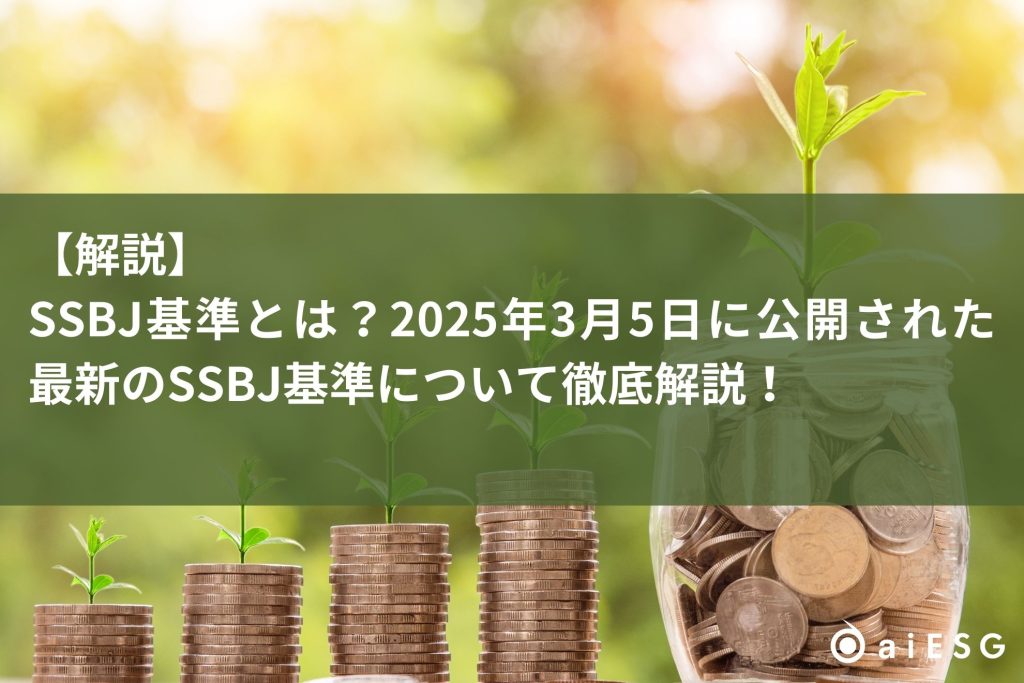INDEX
Since the release of the final proposal on September 18, 2023, there has been more activity surrounding the TNFD. In the past two articles on this website, we have explained the background and outline of the TNFD, as well as the issues involved in the actual disclosure.
Part 1 What is TNFD? A new bridge between finance and the natural environment
https://aiesg.co.jp/topics/report/230913_tnfdreport
2nd TNFD disclosure status and issues
https://aiesg.co.jp/topics/report/230102_tnfdreport2/
In this issue, we will focus on the focus of the TNFD, which has been reemphasized by the final recommendations, and the responses that companies will be required to take in the future.
Key Points of the TNFD Final Recommendations
The Taskforce on Nature-related Financial Disclosures (TNFD) is a framework for disclosing the mutual impacts, risks, and opportunities between companies and natural capital and biodiversity. The Task Force on Nature-related Financial Disclosures is a framework for disclosing the mutual impacts, risks, and opportunities of companies with respect to natural capital and biodiversity.
The beta version v0.4 was released in March 2023 and the final recommendations on September 18, and many companies in Japan are beginning to release TNFD-related reports.
| Company Name | Open to the public | Report |
| Kirin Holdings Company, Limited | July 2022 July 2023 | ."Environmental Report 2022"Environmental Report 2023" |
| Sumitomo Mitsui Financial Group | April 2023 | ."SMBC Group 2023 TNFD Report" |
| Kao Corporation and Accenture, Inc. joint survey | April 2023 | ."Business Risks and Opportunities posed by Biodiversity - TNFD Assessment Case Study on Regional Characteristics" |
| Shiseido Company, Limited | May 2023 | ."2023 Shiseido Climate/Nature-related Financial Disclosure Report " |
| KDDI Corporation | June 2023 | ."TNFD Report 2023" |
| NEC Corporation | July 2023 | ."NEC TNFD Report 2023" |
| tokyu land holdings inc. | August 2023 | ."TNFD Report - Contribution to Nature Positive in the Tokyu Land Holdings Group" |
| Kyushu Electric Power Group | September 2023 | ."Kyuden Group TNFD Report 2023" |
Commentary] From TNFD Disclosure Status and Issueshttps://aiesg.co.jp/topics/report/230102_tnfdreport2/
Although the final proposal changes little from the previous structure, the text of some of the general requirements and disclosure recommendations has been changed, and a variety of additional guidance has been released simultaneously to clarify the overall picture of the information that the TNFD requires to be disclosed. Some of the points that have been reemphasized include the following
1. involvement of local stakeholders
Of the 14 disclosure recommendations located under the four pillars (Figure 1), the description of stakeholder engagement, which was in the "Risk and Impact Management" section until the beta version v0.4, has been reorganized as C in "Governance". Accordingly, references to indigenous peoples and local communities have been added, as well as a description of board and management oversight. Additional indicators recommended for disclosure for all sectors also introduced a section on agreements with stakeholders in the area of operation and the impact on them (Table 2), as well as additional guidance on "involvement of indigenous peoples, local communities, and affected stakeholders" [1].

Figure 1: TNFD Disclosure Recommendations (Source:Executive summary of the recommendations of the TNFD)
Table 2: Additional Global Disclosure Indicators Related to Stakeholders
(Source: Prepared by the author from Recommendations of the Taskforce on Nature-related Financial Disclosures)
| index number | category | summary |
| A20.0 | Category: Strategy Subcategory: Engagement | Percentage of sites actively agreeing with local stakeholders on nature-related issues |
| A20.1 | Category: Strategy Subcategory: Engagement | Participation in sector-wide and/or multi-stakeholder agreements (number of agreements; number of stakeholders and stakeholder groups covered) |
| A24.3 | Category: Dependencies, Impacts, Risk and Opportunity Management Subcategory: Voluntary Preservation, Restoration, Rehabilitation | Value of investments in nature-related community development programs aimed at enhancing positive impacts on indigenous peoples and affected stakeholders |
The TNFD emphasizes the importance of indigenous peoples and local communities, stating that their knowledge and community practices have helped protect ecosystems [2]. One of the main features of the TNFD is that it requires disclosure of not only direct indicators about climate and resources, but also social and economic items related to nature.
2. relationship with other frameworks
The TNFD, and the LEAP approach recommended for use in TNFD disclosure, has been developed in conjunction with various other frameworks and tools (Figure 2).

Figure 2: Frameworks and tools related to TNFD
(Source:Recommendations of the Taskforce on Nature-related Financial Disclosures)
In particular, 11 of the 14 disclosure recommendations are shared with the Task Force on Climate-related Financial Disclosures (TCFD). The standards are also consistent with those developed by the International Sustainability Standards Board (ISSB). This is intended to meet the information needs of capital providers and lead to more effective disclosure.
On the corporate side, the high relevance of the TNFD to the existing framework is also expected to lower the disclosure hurdle. Although the nature of the TNFD's nature-related nature requires a large number of indicators, the use of already adopted measurement indicators can begin the discussion of information disclosure, even if only partially.
Publication of Getting Started Guide
Various additional guidance was released with the final recommendations (Figure 3), including details on the LEAP approach, scenario analysis, and guidance by sector and biome, which had been announced in the beta version, and now a new Getting Started Guide for getting started with TNFD has been added. The new Getting Started Guide has been added to the TNFD.

Figure 3: TNFD Recommendations and Additional Guidance (Source:Executive summary of the recommendations of the TNFD)
This guidance provides practical steps leading up to the TNFD disclosure, considerations, and findings from the beta pilot test. It provides information on key steps that should be considered by companies considering disclosure (Figure 4), and other tips for moving forward with disclosure.

Figure 4: Seven Key Steps to Start and Improve TNFD Disclosure
(Source:Getting started with adoption of the TNFD Recommendations)
Discussion on TNFD Voluntary Disclosure
As we have mentioned, the TNFD inherits much of its structure from the TCFD, a climate change-related framework. In Japan, disclosure of information based on the TCFD or equivalent standards has been mandatory since 2022, and the rate of compliance is among the highest in the world [3].
TNFD expects this framework to spread more quickly, similar to the TCFD [4] In a survey conducted by TNFD in the summer of 2023, 70% of companies and financial institutions said they could begin disclosing by FY2025 and 86% by FY2026. by FY2025. The percentage of respondents who said they would be able to begin disclosures was 761 TP3T for corporations and 631 TP3T for financial institutions, suggesting that corporations may be able to begin disclosures sooner than financial institutions. (Figure 5).

Figure 5: Projection of when organizations can begin TNFD disclosure
(Source:Getting started with adoption of the TNFD Recommendations)
On the other hand, the disclosure of TNFD information is currently left solely to the autonomy of the organization, and the hurdles to disclosure remain high for many companies due to the variety of indicators and the difficulty of evaluation. The above survey also indicates a partial, rather than a complete, start of disclosure, and where among the 14 recommendations companies and industries can begin disclosure varies from company to company. Given this situation, it is possible that disclosure will be phased in starting with indicators that are closely related to each company.
Society's interest in biodiversity and the mutual impact of nature and business activities is growing even stronger. It is quite possible that pressure from investors and other parties in Japan and abroad will force companies to start disclosing information before it becomes mandatory or regulated by law. First of all, it is necessary to understand the contact points between your company and nature, and to discuss step-by-step how much information is currently available and what information is lacking.
Conclusion
With the release of the final recommendations, it is expected that more attention will be paid to the TNFD than ever before. It is not an easy task for many companies to disclose information in compliance with the TNFD, which requires not only data directly related to the environment, but also community and economic indicators.
The services provided by aiESG enable ESG analysis not only on a company or business unit basis, but also on a product or service basis. In addition to indicators such as greenhouse gas emissions, which can be measured by conventional services, aiESG can also quantitatively capture social and natural environmental aspects required by the TNFD, including community impacts and indigenous peoples' rights. In addition to GHG emissions and other indicators that can be measured by conventional services, the TNFD also quantitatively captures social and natural environmental aspects required by the TNFD, such as community impacts and indigenous rights. Furthermore, for each of these items, it is possible to identify hotspots in the supply chain where risk is high, leading to the identification of priority areas of high risk.
Because it is difficult to reach disclosure overnight in this framework, it is necessary to first reaffirm the challenges of one's own business and discuss disclosure from the point at hand, so as not to fall behind the industry and social trends.
aiESG provides support from the basics of TNFD to the actual disclosure of non-financial information, so if your company is having trouble with TNFD, please contact us.
Contact us:
https://aiesg.co.jp/contact/
Bibliography
[1] https://tnfd.global/wp-content/uploads/2023/08/Guidance_on_engagement_with_Indigenous_Peoples_Local_Communities_and_affected_stakeholders_v1.pdf?v=1695138220
[2] https://tnfd.global/wp-content/uploads/2023/08/Recommendations_of_the_Taskforce_on_Nature-related_Financial_Disclosures_September_2023.pdf?v=1695118661
[3] https://project.nikkeibp.co.jp/ESG/atcl/column/00004/022400030/
[4] https://tnfd.global/wp-content/uploads/2023/09/Getting_started_TNFD_v1.pdf?v=1695138203
Related page
【【Explanation] What is TNFD? A new bridge between finance and the natural environment
https://aiesg.co.jp/topics/report/230913_tnfdreport/
Commentary] TNFD Disclosure Status and Issues
https://aiesg.co.jp/topics/report/230102_tnfdreport2/
aiESG Participates in the Task Force on Nature-related Financial Disclosures (TNFD) Forum
https://aiesg.co.jp/topics/news/2309_tnfd/
















